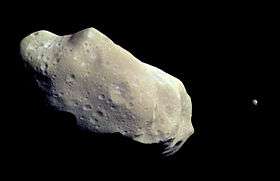Juliet (moon)
Juliet is an inner satellite of Uranus. It was discovered from the images taken by Voyager 2 on 3 January 1986, and was given the temporary designation S/1986 U 2.[8] It is named after the heroine of William Shakespeare's play Romeo and Juliet. It is also designated Uranus XI.[9]
- There is also an asteroid called 1285 Julietta.
 | |
| Discovery | |
|---|---|
| Discovered by | Stephen P. Synnott / Voyager 2 |
| Discovery date | January 3, 1986 |
| Designations | |
Designation | Uranus XI |
| Pronunciation | /ˈdʒuːliɛt/[1] |
| Adjectives | Julietian[2] |
| Orbital characteristics | |
| 64,358.222 ± 0.048 km[3] | |
| Eccentricity | 0.00066 ± 0.000087[3] |
| 0.493065490 ± 0.000000012 d[3] | |
| Inclination | 0.06546 ± 0.040° (to Uranus' equator)[3] |
| Satellite of | Uranus |
| Physical characteristics | |
| Dimensions | 150 × 74 × 74 km[4] |
Mean radius | 46.8 ± 4 km[4][5][6] |
| ~35,000 km²[lower-alpha 1] | |
| Volume | ~632,000 km³[lower-alpha 1] |
| Mass | ~5.6×1017 kg[lower-alpha 1] |
Mean density | ~1.3 g/cm³ (assumed)[5] |
| ~0.016 m/s2[lower-alpha 1] | |
| ~0.040 km/s[lower-alpha 1] | |
| synchronous[4] | |
| zero[4] | |
| Albedo | 0.08 ± 0.01[7] |
| Temperature | ~64 K[lower-alpha 1] |
Juliet belongs to Portia Group of satellites, which also includes Bianca, Cressida, Desdemona, Portia, Rosalind, Cupid, Belinda and Perdita.[7] These satellites have similar orbits and photometric properties.[7] Unfortunately, other than its orbit,[3] radius of 53 km[4] and geometric albedo of 0.08[7] virtually nothing is known about Juliet.
At the Voyager 2 images Juliet appears as an elongated object, the major axis pointing towards Uranus. The ratio of axes of Juliet's prolate spheroid is 0.5 ± 0.3, which is rather an extreme value.[4] Its surface is grey in color.[4]
Juliet may collide with Desdemona within the next 100 million years.[10]
See also
References
Explanatory notes
- Calculated on the basis of other parameters.
Citations
- Benjamin Smith (1903) The Century Dictionary and Cyclopedia
- W. M. Anderson (1892) 'Daniel Johnson Brimm', Shield and Diamond, vol. 2, no. 1, p. 116
- Jacobson, R. A. (1998). "The Orbits of the Inner Uranian Satellites From Hubble Space Telescope and Voyager 2 Observations". The Astronomical Journal. 115 (3): 1195–1199. Bibcode:1998AJ....115.1195J. doi:10.1086/300263.CS1 maint: ref=harv (link)
- Karkoschka, Erich (2001). "Voyager's Eleventh Discovery of a Satellite of Uranus and Photometry and the First Size Measurements of Nine Satellites". Icarus. 151 (1): 69–77. Bibcode:2001Icar..151...69K. doi:10.1006/icar.2001.6597.
- "Planetary Satellite Physical Parameters". JPL (Solar System Dynamics). 24 October 2008. Retrieved 12 December 2008.
- Williams, Dr. David R. (23 November 2007). "Uranian Satellite Fact Sheet". NASA (National Space Science Data Center). Retrieved 12 December 2008.
- Karkoschka, Erich (2001). "Comprehensive Photometry of the Rings and 16 Satellites of Uranus with the Hubble Space Telescope". Icarus. 151 (1): 51–68. Bibcode:2001Icar..151...51K. doi:10.1006/icar.2001.6596.
- Smith, B. A. (January 16, 1986). "Satellites of Uranus". IAU Circular. 4164. Retrieved 29 October 2011.
- "Planet and Satellite Names and Discoverers". Gazetteer of Planetary Nomenclature. USGS Astrogeology. July 21, 2006. Retrieved 6 August 2006.
- Duncan, Martin J.; Lissauer, Jack J. (1997). "Orbital Stability of the Uranian Satellite System". Icarus. 125 (1): 1–12. Bibcode:1997Icar..125....1D. doi:10.1006/icar.1996.5568.CS1 maint: ref=harv (link)
External links
- Juliet Profile by NASA's Solar System Exploration
- Juliet + Ring diagram (Courtesy of Astronomy Magazine 2005)
- Uranus' Known Satellites (by Scott S. Sheppard)


